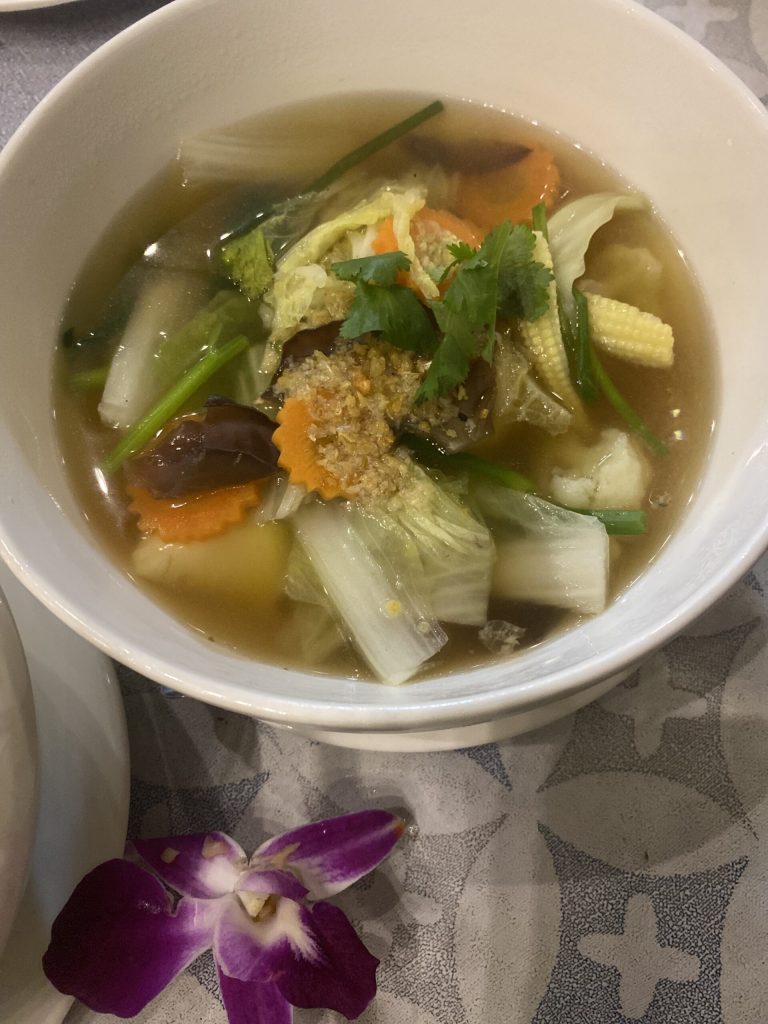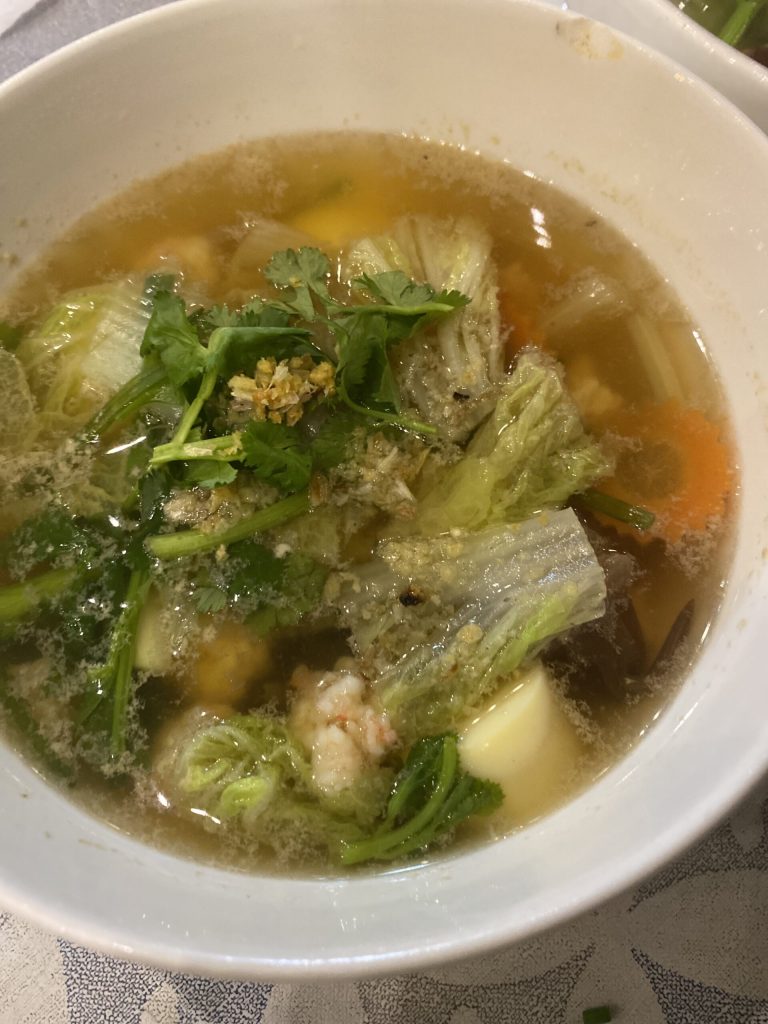The Gaeng Om Soup is a clear Thai chicken soup with Isan herbs, in a water-based curry that does not require coconut milk.
Even the curry paste (nam pla ra) is not the typical green Thai curry paste or massaman curry, but a light and simple paste, only 5 ingredients: lemongrass, galangal, chilies, shallots, and garlic.
Gaeng: in Thai it translates to “curry” or “soup”.
Om: refers to a type of Isan food, a water-based curry prepared without coconut milk, with many seasonal and regional vegetables.
This is a typical recipe from Northeast Thailand, always prepared with dill, which gives it its characteristic flavor.
During the trip to Ao Nang in October 2024 with my mother, we tasted the Gaeng Om Soup at Jungle Kitchen restaurant, and my mother opted for a version with shrimp.
Other recipes tasted during the trip to Thailand with my mother and two other friends:

- Difficulty: Very Easy
- Cost: Very Cheap
- Preparation time: 5 Minutes
- Portions: 4 People
- Cooking methods: Boiling
- Cuisine: Thai
- Seasonality: All Seasons
Ingredients
- 2 stalks lemongrass
- 1 galangal (diced)
- 3 Bird's eye chilies (seeded and chopped)
- 3 shallots (chopped)
- 3 cloves garlic (chopped)
- 4 cups cups chicken broth
- 1 teaspoon fish sauce
- 5 kaffir lime leaves
- 4 scallion stalks (sliced)
- 1/4 cup Thai basil
- to taste baby corn
- to taste Pleurotus mushrooms
- to taste bok choy
- 2 carrots (sliced)
- to taste dill
Steps
Using a mortar and pestle or a food processor, crush or blend the lemongrass, galangal, shallots, garlic, and chilies until you obtain a coarse paste.

Bring the chicken broth to a boil.
Add the fish sauce, kaffir lime leaves (if you wish to include chicken or shrimp version, add them now), the baby corn, carrot, mushrooms, and green beans, and simmer for about 5-10 minutes until the vegetables are tender and the chicken is cooked. Add the bok choy and let it simmer for 1-2 minutes without wilting.
Turn off the heat and add the scallions, dill, and Thai basil.
Pour into individual bowls and add condiments to taste, such as coriander and toasted garlic.Serve with a side of jasmine rice, optional.

FAQ (Questions and Answers)
What is Isan cuisine?
Isan is the northeastern part of Thailand.
Isan cuisine is loved for its simplicity and authenticity. Locals make the most of what they have, often enjoying their dishes with a side of homegrown vegetables.
The basic ingredients of Isan cuisine are: sticky rice, along with vegetables, spices, and fish, roasted rice powder (khao khua), and fermented fish sauce; pla ra or fermented fish, locals love to use it for dipping or seasoning food.
It is salty and has a strong smell, which is not everyone’s favorite.
Typical Isan recipes include: larb, som tam, and Nam Tok MooIsan is the northeastern part of Thailand.
Isan cuisine is loved for its simplicity and authenticity. Locals make the most of what they have, often enjoying their dishes with a side of homegrown vegetables.
The basic ingredients of Isan cuisine are: sticky rice, along with vegetables, spices, and fish, roasted rice powder (khao khua), and fermented fish sauce; pla ra or fermented fish, locals love to use it for dipping or seasoning food.
It is salty and has a strong smell, which is not everyone’s favorite.
Typical Isan recipes include: larb, som tam, and Nam Tok MooWhat is Thai basil?
Thai Basil (Ocimum basilicum var. thyrsiflora) or Thai basil (Ocimum basilicum var. thyrsiflora) is a mildly spicy basil with anise and licorice flavor, also known as horapha in the Thai language.
With its purple stems and purple-veined leaves on a glossy dark green background, these plants are grown not only for their culinary uses but also as ornamental specimens.
Thai basil is widely used in Southeast Asian cuisines, such as Thai, Vietnamese, Lao, and Cambodian cuisines.
It is best consumed raw, in fact, a plate of raw Thai basil leaves is often served as an accompaniment to the Vietnamese pho soup.
The plant is said to have the ability to bring good luck to those who use it while protecting them from evil spirits. If a leaf is put in one’s pocket, money will soon enter the pocket.Thai Basil (Ocimum basilicum var. thyrsiflora) or Thai basil (Ocimum basilicum var. thyrsiflora) is a mildly spicy basil with anise and licorice flavor, also known as horapha in the Thai language.
With its purple stems and purple-veined leaves on a glossy dark green background, these plants are grown not only for their culinary uses but also as ornamental specimens.
Thai basil is widely used in Southeast Asian cuisines, such as Thai, Vietnamese, Lao, and Cambodian cuisines.
It is best consumed raw, in fact, a plate of raw Thai basil leaves is often served as an accompaniment to the Vietnamese pho soup.
The plant is said to have the ability to bring good luck to those who use it while protecting them from evil spirits. If a leaf is put in one’s pocket, money will soon enter the pocket.What are the three types of basil used in Thai cooking?
The Thai basil, or horapha (in Thai: โหระพา), is widely used throughout Southeast Asia and plays a prominent role in Vietnamese cuisine. It is the most commonly used cultivar for Asian cooking in Western kitchens.
The holy basil (O. tenuiflorum), mreah-pruv (Khmer: ម្រះព្រៅ), or kaphrao (Thai: กะเพรา), which has a spicy, peppery, clove-like flavor, might be the most beloved basil among Thais.
It is also known as Thai holy basil or by its Indian name, tulasi or tulsi; it is widely used in India for culinary, medicinal, and religious purposes.
The lemon basil (O. × citriodorum), or maenglak (Thai: แมงลัก), as the name suggests, has lemon undertones in its aroma and flavor.
The least commonly used type of basil in Thailand.
It is also known as Thai lemon basil, as opposed to Mrs. Burns’ lemon basil, another cultivar.
The Thai basil, or horapha (in Thai: โหระพา), is widely used throughout Southeast Asia and plays a prominent role in Vietnamese cuisine. It is the most commonly used cultivar for Asian cooking in Western kitchens.
The holy basil (O. tenuiflorum), mreah-pruv (Khmer: ម្រះព្រៅ), or kaphrao (Thai: กะเพรา), which has a spicy, peppery, clove-like flavor, might be the most beloved basil among Thais.
It is also known as Thai holy basil or by its Indian name, tulasi or tulsi; it is widely used in India for culinary, medicinal, and religious purposes.
The lemon basil (O. × citriodorum), or maenglak (Thai: แมงลัก), as the name suggests, has lemon undertones in its aroma and flavor.
The least commonly used type of basil in Thailand.
It is also known as Thai lemon basil, as opposed to Mrs. Burns’ lemon basil, another cultivar.

